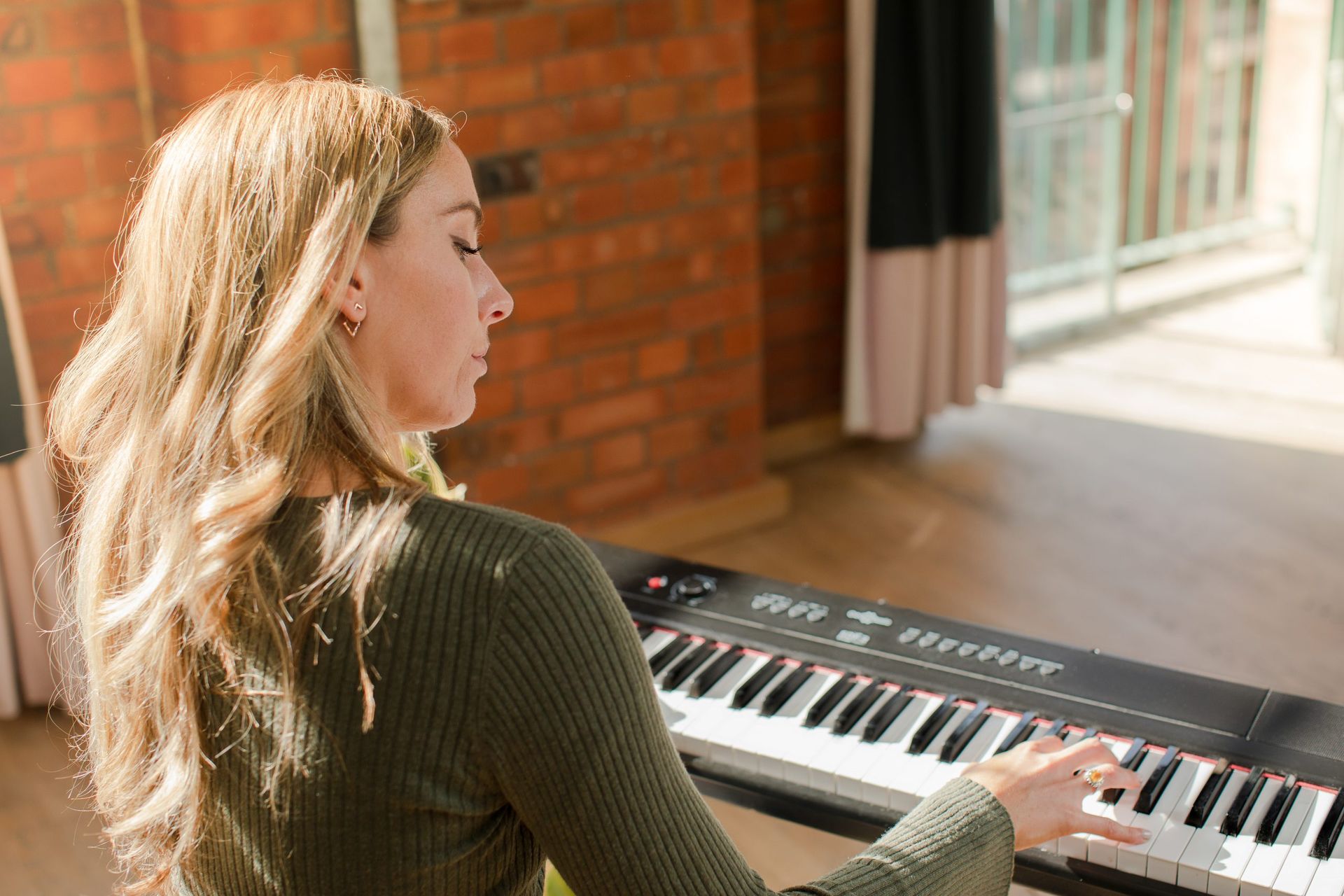Home>Production & Technology>Tempo>What Tempo Music For Running


Tempo
What Tempo Music For Running
Modified: January 22, 2024
Discover the perfect tempo music for running and enhance your workout experience. Find the ideal rhythm to keep you motivated and energized throughout your run.
(Many of the links in this article redirect to a specific reviewed product. Your purchase of these products through affiliate links helps to generate commission for AudioLover.com, at no extra cost. Learn more)
Table of Contents
Introduction
Running is a popular form of exercise that is not only great for physical fitness but also for mental well-being. Many runners find that listening to music while running enhances their performance and makes the experience more enjoyable. One key factor to consider when selecting music for running is the tempo, which refers to the speed or pace of a piece of music.
The tempo of a song can directly impact a runner’s pace, motivation, and overall performance. Choosing the right tempo can help runners maintain a steady rhythm and improve their running efficiency. In this article, we will explore the significance of tempo in running and provide insights on how to select the ideal tempo for your runs, as well as tips for creating an energizing running playlist.
Whether you’re a seasoned runner or just starting out, understanding the relationship between music tempo and running can make a profound difference in your workouts. So, let’s dive in and uncover the impact of tempo on running performance.
The Impact of Tempo on Running Performance
The tempo of music can have a significant impact on running performance. It can help runners maintain a consistent and optimal pace, improve motivation and focus, and enhance overall running efficiency.
When running to music, the body naturally synchronizes with the rhythm and beat of the songs. This synchronization can help runners maintain a steady cadence and stride, which is crucial for efficient running. Studies have shown that running at an optimal cadence can reduce the risk of injuries and improve running economy.
Choosing music with a tempo that matches your desired running pace can be a powerful tool for improving performance. Faster tempo music can energize and push you to run at a quicker pace, while slower tempo music can help you relax and maintain a steady pace during long-distance runs.
Moreover, music with a strong and consistent beat can help distract from fatigue, increase focus, and improve mental resilience during challenging runs. It can serve as a positive distraction and provide an extra motivational boost when you need it the most.
Additionally, running with music can enhance the overall enjoyment of your runs. The right tempo and rhythm can evoke emotions, create a sense of rhythm, and even elevate your mood. This can make your running experience more pleasurable and help you stay motivated and engaged throughout your workout.
Overall, choosing music with an appropriate tempo can have a profound impact on your running performance by helping you maintain a consistent pace, improving motivation and focus, and enhancing your overall running efficiency. In the next section, we will discuss how to determine the ideal tempo for your runs.
Determining the Ideal Tempo for Running
Finding the ideal tempo for your runs depends on various factors, including your running ability, fitness level, and personal preferences. Here are a few methods to help you determine the ideal tempo for your running sessions:
1. Cadence Matching: One approach is to match your running cadence with the beats per minute (BPM) of the music. Cadence refers to the number of steps or strides you take per minute. The optimal cadence for running typically falls within the range of 160-180 steps per minute. You can use a metronome or various smartphone apps that provide BPM information to select songs with a matching tempo.
2. Rate of Perceived Exertion (RPE): Another method is to consider your rate of perceived exertion, which is how hard you feel you are working during a run. If you want to do an easy run, select music with a slower tempo that keeps your RPE low. For a challenging interval or speed training session, choose music with a higher tempo to push your limits.
3. Trial and Error: Experiment with different tempos during your runs to see how they affect your performance. Start with a slower tempo and gradually increase it to find the sweet spot where you feel comfortable and motivated. Take note of your pace, energy levels, and overall experience to determine what works best for you.
4. Use Running Playlist Services: There are several online platforms and apps that curate running playlists based on BPM and genre preferences. These services can make it easier for you to discover songs with the right tempo for your runs without the hassle of manually searching for them.
Remember, the ideal tempo for running may vary depending on factors such as your running goals, workout type (long run, speed work, recovery run), and personal taste in music. It’s important to find a tempo that keeps you motivated, allows you to maintain proper form and cadence, and enhances your overall running experience.
Now that you have an understanding of how to determine the ideal tempo for your runs, let’s explore the benefits of running with music in the next section.
Benefits of Running with Music
Running with music has been a popular choice for many runners, and it comes with several benefits that can enhance your overall running experience. Here are some of the advantages of running with music:
1. Increased Motivation: Music has the power to motivate and inspire. Listening to uplifting and energizing songs can boost your mood, increase your motivation, and help you push through challenging runs. The right music can provide a mental and emotional lift when you need it the most.
2. Distraction from Fatigue: When running long distances or engaging in strenuous workouts, fatigue can set in and make the run feel more difficult. Music serves as a positive distraction that can divert your attention away from fatigue and discomfort, helping you push through tough moments and maintain your performance.
3. Improved Performance: Synchronizing your running with the rhythm and beat of music can help you maintain a consistent pace and stride. This can result in improved running efficiency and performance. Matching your steps to the music can also help you establish a better cadence, which in turn can reduce the risk of injuries and enhance running economy.
4. Enhanced Focus and Zone of Flow: Music can take you into a state of flow where you are fully absorbed in your run. It can help you enter a focused and meditative state that allows you to disconnect from external distractions and fully immerse yourself in the running experience.
5. Elevates Mood and Enjoyment: Listening to music that you enjoy can have a positive impact on your mood and overall enjoyment of running. It can create a sense of rhythm, evoke emotions, and make your runs more pleasurable. This can further increase your motivation and make your workouts feel less like a chore.
6. Personalized Running Experience: Music allows you to curate a personalized running experience by selecting songs that resonate with you. You can create playlists that match your mood, running goals, or specific types of runs. This personalization adds a fun and customized element to your runs.
As with any aspect of running, it’s important to strike a balance. Make sure to still be aware of your surroundings and consider safety guidelines, such as using headphones that allow ambient noise to pass through or keeping the volume at a level where you can still hear important sounds around you.
Now that you’re aware of the benefits of running with music, let’s explore some key factors to consider when choosing the tempo for your running songs in the next section.
Factors to Consider When Choosing Music Tempo
When selecting music for your runs, it’s important to consider various factors to ensure that the tempo aligns with your running goals and preferences. Here are some key factors to keep in mind when choosing the tempo for your running songs:
1. Running Pace: Consider your desired running pace or the pace at which you feel most comfortable. If you are aiming for a faster pace, select songs with a higher tempo to match and motivate your speed. On the other hand, if you prefer a slower and more relaxed pace, choose songs with a lower tempo.
2. Workout Type: Different types of runs require different tempos. For shorter interval or speed runs, opt for songs with a higher tempo to match the intensity of the workout. For longer endurance runs or recovery runs, songs with a slower tempo can help you maintain a steady and relaxed pace.
3. Personal Preference: Listen to music that you enjoy and that resonates with you. Consider your musical taste and preferences when choosing songs for your running playlist. Running with music you love can be more enjoyable and keep you motivated throughout your runs.
4. Rhythm and Beat: Pay attention to the rhythm and beat of the songs. Look for music that has a strong and consistent beat that aligns with your preferred running cadence. This can help you establish and maintain a steady stride and enhance your running efficiency.
5. Energy Level: Consider the energy level you want to bring to your runs. If you need a burst of energy and motivation, choose songs with a higher tempo that have a more energetic and upbeat vibe. For a more relaxed and calming run, select songs with a lower tempo that promote a tranquil atmosphere.
6. Music Genre: Different music genres have varying tempos. Explore genres such as pop, rock, electronic, or hip-hop, which often have songs with a wide range of tempos to suit different running styles and preferences.
7. Experimentation: Don’t be afraid to experiment with different tempos and songs during your runs. Try incorporating various tempos into your playlist and observe how they affect your running performance and enjoyment. Trust your intuition and adjust accordingly based on what feels right for you.
Remember, the ideal tempo for your runs may evolve over time as your fitness level and running goals change. Stay open to exploring new music and adjusting your playlist as needed to keep your runs fresh and engaging.
Now that you have a better understanding of the factors to consider when choosing music tempo, let’s explore some popular tempo ranges for running in the next section.
Popular Tempo Ranges for Running
When it comes to selecting music for running, it can be helpful to have an idea of popular tempo ranges that are commonly used by runners. These tempo ranges can serve as a starting point for creating your running playlist. Here are some popular tempo ranges for running:
1. Slow Tempo (120-140 BPM): This tempo range is suitable for warm-up or cool-down exercises, as well as recovery runs. The slower pace provides a relaxed and comfortable rhythm that allows for easy breathing and a gentle pace.
2. Moderate Tempo (140-160 BPM): The moderate tempo range is ideal for steady-state runs or endurance runs. It provides a rhythmic pace that allows for a consistent and sustainable effort. This range is commonly used for longer training runs and can help you maintain a balanced and efficient stride.
3. Fast Tempo (160-180 BPM): This tempo range is best suited for interval training, speed work, and high-intensity runs. The fast pace promotes a sense of energy and urgency, encouraging you to push your limits and increase your running speed. It can help improve your cardiovascular endurance and overall running performance.
Please note that these tempo ranges are general guidelines and may vary depending on your running abilities and preferences. Some runners may find a slower or faster tempo more suitable for their personal running style.
It’s also worth mentioning that tempo ranges can vary based on the music genre. For example, electronic dance music (EDM) often has higher tempos, while classical music or ballads tend to have slower tempos. Consider experimenting with different genres to find the perfect tempo range that matches your running style.
Once you have identified your preferred tempo range, it’s time to consider how to adjust the tempo for different types of runs, which we will explore in the next section.
Adjusting Tempo for Different Types of Runs
As a runner, you may engage in various types of runs, each serving a specific purpose in your training program. Adjusting the tempo of your music playlist to match the intensity and objective of your run can enhance your performance and maximize the effectiveness of your workouts. Here are some tips on adjusting the tempo for different types of runs:
1. Long Runs: For long-distance runs, aim for a moderate tempo in the range of 140-160 BPM. This tempo helps maintain a steady and sustainable pace throughout the run without pushing too hard. It creates a rhythmic flow that can help you stay focused and motivated during an extended effort.
2. Interval Training and Speed Work: When performing interval training or speed work, incorporate faster tempo songs in the range of 160-180 BPM. The energetic and upbeat music will help you tap into your fast-twitch muscles and push yourself during high-intensity intervals.
3. Recovery Runs: Recovery runs are meant to be relaxed and light, allowing your body to recover from intense workouts. Choose songs in the slower tempo range of 120-140 BPM to promote a gentle and comfortable rhythm. This tempo supports a more leisurely pace, helping you recover while still enjoying your run.
4. Hills and Sprints: When tackling hilly routes or incorporating sprint training, opt for faster tempo songs in the upper range of 160-180 BPM. The lively music will provide an extra boost of energy and motivation to conquer challenging terrain or deliver powerful bursts of speed.
5. Warm-Up and Cool-Down: During warm-up and cool-down exercises, it’s beneficial to choose songs with a slower tempo in the range of 120-140 BPM. This tempo helps ease your body into exercise or gradually bring your heart rate down. The relaxed rhythm facilitates a smooth transition into or out of intense workouts.
Remember, these tempo suggestions are not set in stone and can be adjusted based on your personal preferences and running abilities. Feel free to experiment with different tempos and listen to your body to find what works best for you.
Now that you have a better understanding of adjusting the tempo for different types of runs, let’s move on to some practical tips for creating a running playlist in the next section.
Tips for Creating a Running Playlist
A well-curated running playlist can provide the perfect soundtrack for your runs and keep you motivated and energized. Here are some tips to help you create an engaging and effective running playlist:
1. Mix Up the Tempo: Include a mix of songs with different tempos to cater to different types of runs. Include slower tempo songs for warm-ups and cool-downs, moderate tempo songs for steady-state runs, and faster tempo songs for high-intensity workouts.
2. Start Strong: Begin your playlist with a couple of high-energy, upbeat songs to kickstart your run with enthusiasm and motivation. This can help set the tone for your entire run and get you in the right mindset.
3. Create Peaks and Valleys: Structure your playlist to have a mix of songs with varying energy levels. Alternate between faster-paced and slower-paced songs to create a balance and keep your energy levels steady throughout your run.
4. Include Personal Favorites: Add songs that you genuinely enjoy and that make you feel good. The emotional connection with the music can boost your mood and enhance your overall running experience.
5. Playlists for Different Moods: Consider creating separate playlists for different moods or types of runs. You might have a playlist for high-energy runs, one for relaxing and therapeutic runs, and another for races or speed sessions. This can help you select the perfect playlist based on your mood and objectives for the run.
6. Update Your Playlist: Regularly update your playlist by adding new songs and rotating older ones. This helps keep your playlist fresh and prevents it from becoming monotonous or losing its effectiveness over time.
7. Use Shuffling Feature: Take advantage of the shuffle feature on your music player to bring variety to your runs. This can keep you guessing which song is coming up next and add an element of surprise to your playlist.
8. Experiment and Adjust: Don’t be afraid to experiment and adjust your playlist based on your evolving running needs and preferences. Pay attention to how different songs and tempos affect your performance, motivation, and enjoyment, and make changes accordingly.
Remember, your running playlist is a personal and individual choice. Customize it to fit your unique taste and running style. Ultimately, the goal is to create a playlist that keeps you engaged, motivated, and energized throughout your runs.
Now that you have some valuable tips for creating a running playlist, let’s wrap up the article in the next section.
Conclusion
Choosing the right tempo of music for running can greatly enhance your performance, motivation, and overall enjoyment. The tempo of your running music impacts your pace, cadence, and mental focus, allowing you to optimize your running experience.
In this article, we explored the impact of tempo on running performance and the factors to consider when choosing music tempo for your runs. We discussed the benefits of running with music, including increased motivation, distraction from fatigue, improved performance, enhanced focus, and a personalized running experience.
We also delved into popular tempo ranges for running, such as slow tempo (120-140 BPM), moderate tempo (140-160 BPM), and fast tempo (160-180 BPM). Adjusting the tempo for different types of runs, such as long runs, interval training, recovery runs, and hill sprints, can further optimize your workouts.
Moreover, we provided tips for creating a running playlist, emphasizing the importance of mixing up the tempo, including personal favorites, creating peaks and valleys, and regularly updating the playlist to keep it fresh and engaging.
Remember, finding the ideal tempo and creating a personalized running playlist may require some experimentation and tweaking. Pay attention to how different tempos affect your running performance, motivation, and enjoyment, and tailor your playlist to meet your unique needs and preferences.
So go ahead and select your favorite tunes, find that perfect tempo, and let the music invigorate your running sessions. Let the rhythm guide your stride, and enjoy the benefits of running with music as you achieve your fitness goals. Lace up your running shoes, press play, and let the music carry you through your runs with a renewed sense of energy and inspiration!











